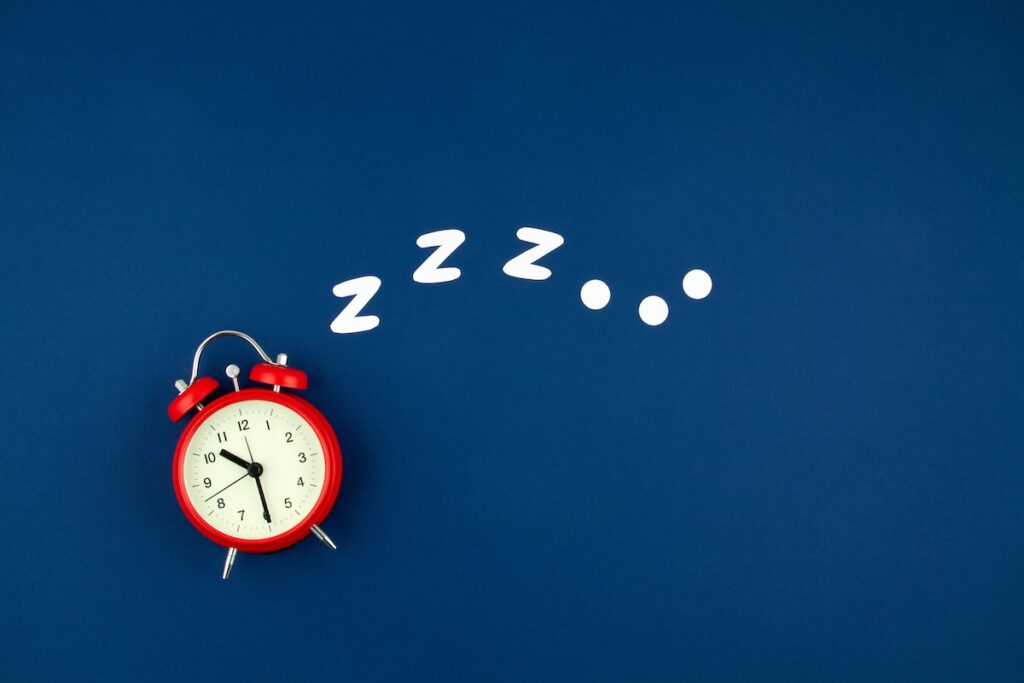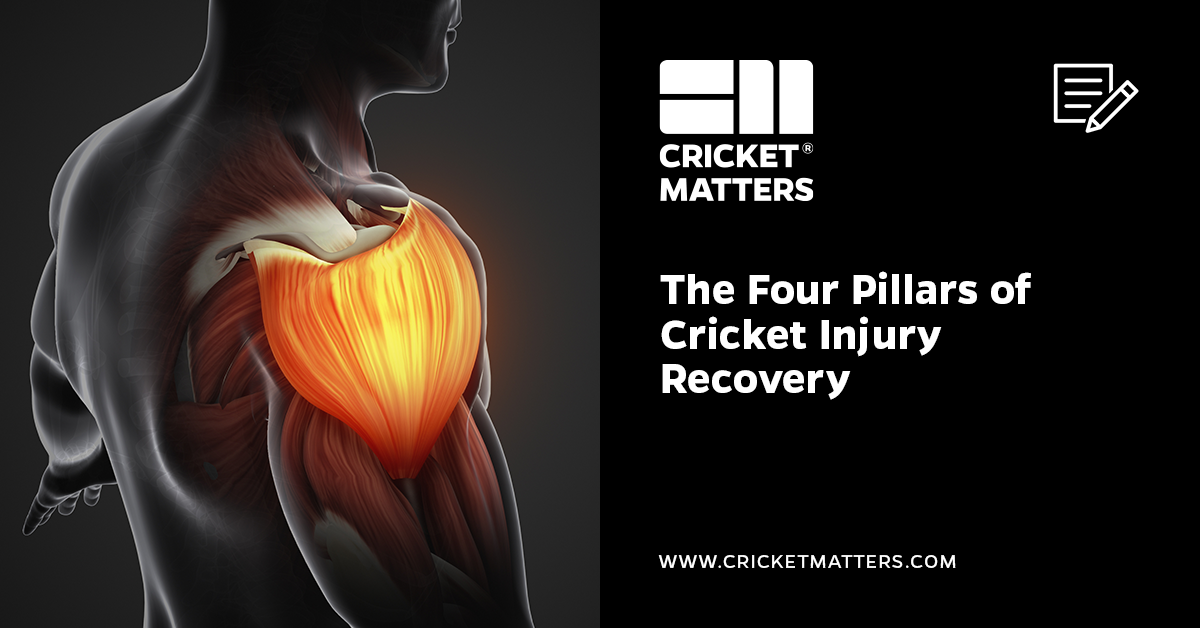
I hope you enjoy reading this blog post.
James Breese, Cricket Matters FounderIf you need my help with cricket coaching, strength and conditioning, injury rehab, or nutrition, click here.
Cricket is a demanding sport, and injuries are unfortunate but common. I’m yet to meet a cricketer who hasn’t suffered a cricket injury.
From fast bowlers experiencing back pain to batsmen dealing with repetitive stress injuries on their elbows, the sport places significant physical demands on its players.
However, recovery from these injuries requires more than rest and medical treatment. A holistic approach to injury recovery is essential to ensure a full recovery and enhance future performance on the field.
A holistic recovery approach in cricket involves addressing four critical areas: physical rehabilitation, proper nutrition, mental well-being, and adequate rest and sleep.
Each component plays a vital role in the healing process and can significantly accelerate recovery while improving overall performance.
- Physical Rehabilitation: Engaging in targeted physical therapy and rehabilitation exercises helps to promote healing, restore function, and prevent future injuries.
- Nutrition: Maintaining a balanced diet rich in essential nutrients supports tissue repair and overall health, providing the body with the resources it needs to heal.
- Mental Well-being: Incorporating meditation and mindfulness practices can help manage stress, reduce pain, and improve mental resilience, crucial for maintaining focus and motivation during recovery.
- Adequate Rest and Sleep: Ensuring sufficient sleep and rest is crucial for recovery, as sleep aids in muscle repair, hormone regulation, and overall healing processes.
By integrating these four elements, cricketers can achieve a more comprehensive and effective recovery, leading to better performance and longevity in the sport.
This guide will explore each component in detail, providing practical tips and strategies to help cricketers recover from injuries and return to the field stronger than ever.
This over 20 years of personal and professional experience of being both injured and helping others recover from injury, designed to help you recover faster.
Table of Contents
Common Cricketing Injuries

Although cricket is a non-contact sport, it involves a variety of physical activities that often lead to injuries.
Understanding the common injuries in cricket helps in developing better prevention and management strategies.
So, what are they, according to research?
Bowling-Related Injuries:
- Fast bowlers are particularly susceptible to lumbar stress fractures due to the high physical demands and repetitive nature of their actions.
- Bowling accounts for a significant proportion of cricket injuries, ranging from 33% to 65.7% of all injuries (Pardiwala et al., 2017; Stretch, 2001).
Hamstring Strains:
- These are the most common injuries in modern cricket, primarily affecting batsmen and fielders due to sudden bursts of running and changes in direction.
- Hamstring strains occur frequently because of the explosive movements required in batting and fielding (Pardiwala et al., 2017).
Upper Limb Injuries:
- Injuries to the upper limbs, particularly the hand and fingers, are common among fielders.
- These injuries often occur from catching or stopping the ball, leading to fractures and joint injuries (Belliappa & Barton, 1991).
Back and Trunk Injuries:
- These injuries account for 18% to 33.3% of cricket injuries.
- They often result from the physical strain of bowling and batting, which require significant core strength and repetitive twisting motions (Stretch, 2001).
Lower Limb Injuries:
- Lower limb injuries, including ankle sprains and strains, are prevalent among all players, particularly bowlers who face repetitive stress and impacts on their legs.
- These injuries can be exacerbated by uneven playing surfaces and improper footwear (McLeod et al., 2020).
Head Injuries:
- Though less frequent, head injuries can be severe and often result from being struck by the ball.
- They are more common in younger players and can lead to severe outcomes like concussions (Upadhyay & Tan, 2000).
Shoulder Injuries:
- Shoulder injuries, including rotator cuff tears, impingement syndromes, and labral tears, are common among bowlers and fielders due to the repetitive and forceful overhead-throwing actions.
- These injuries often result from scapular dyskinesia, glenohumeral internal rotation deficit, and weak surrounding musculature.
- Effective prevention includes proper training techniques, early diagnosis, and appropriate rehabilitation (Arora et al., 2015); (Dutton et al., 2019).
Effective prevention strategies and appropriate use of protective gear can significantly reduce the incidence and severity of these injuries.
But by understanding these common injuries and their causes, players and coaches can implement better prevention and management strategies, ensuring safer play and longevity in the sport.
But what do you do when you get injured?
That’s when our four pillars of cricket injury rehab come in.
#1 Soft Tissue Work and Rehabilitation

When you’re injured, seeking medical advice from a professional is crucial. You have to know what you’re dealing with. Guess work will prolong your agony.
The biggest mistake many cricketers make is not doing anything about their cricket injury or relying solely on “Dr Google.”
Being proactive about your recovery is essential for a successful return to the field.
Soft tissue work and rehabilitation play a vital role in this process. It’s where you first start.
Physiotherapy techniques, stretching, and exercises specific to cricket-related injuries are fundamental to recovery.
These practices help address the damage to muscles, tendons, and ligaments, ensuring they heal correctly and regain full functionality.
- Physiotherapy: Engaging with a physiotherapist can provide you with a structured rehabilitation plan tailored to your specific injury. Techniques used in physiotherapy can include manual therapy, strength training, and mobility exercises.
- Massage: Regular sports massages can help reduce muscle tension, improve blood flow, and break down scar tissue. This not only alleviates pain but also accelerates the healing process.
- Foam Rolling: Self-myofascial release techniques can help maintain muscle flexibility, reduce soreness, and prevent injuries.
- Sport-Specific Rehabilitation Exercises: These exercises are designed to mimic the movements and stresses of cricket. They help rebuild strength and coordination, which directly translates to improved performance on the field.
Here are some of the benefits of adopting this approach:
- Improved Blood Flow: Enhanced circulation helps deliver essential nutrients to the injured area, promoting faster healing.
- Reduced Scar Tissue: Techniques like massage and physiotherapy help break down scar tissue, ensuring that muscles and tendons regain proper function and flexibility.
- Restored Mobility: Regular stretching and targeted exercises help restore the range of motion, which is crucial for activities like batting, bowling, and fielding.
- Peak Performance Maintenance: These rehabilitation techniques help maintain and even enhance overall performance levels by ensuring that the injury heals correctly and the affected muscles are strengthened.
By being proactive and integrating these soft tissue work and rehabilitation practices into your recovery plan, you can ensure a smoother and more effective return to playing cricket.
The PEACE and LOVE Protocol for Cricket Injuries
The PEACE and LOVE protocol is a modern injury management approach emphasising immediate care and longer-term recovery strategies.
It is particularly useful for soft tissue injuries common in cricket.
PEACE (for the first few days post-injury):
- P – Protect: Avoid activities that could further aggravate the injury. If necessary, use braces or supports to protect the injured area.
- E – Elevate: Keep the injured limb elevated above heart level as much as possible to reduce swelling.
- A – Avoid Anti-Inflammatories: While it might be tempting to use anti-inflammatory medications, they can potentially interfere with the body’s natural healing processes.
- C – Compress: Use compression bandages to help limit swelling and support the injured area.
- E – Educate: Inform yourself about the injury and the healing process. Understanding your injury can help you follow through with the necessary rehabilitation steps.
LOVE (for the following days to weeks after injury):
- L – Load: Gradually introduce movement and load to the injured area to stimulate tissue healing and strength. Follow a structured rehabilitation program.
- O – Optimism: Maintain a positive mindset and set realistic goals. Mental well-being is crucial in the healing process.
- V – Vascularisation: Engage in pain-free cardiovascular activities to increase blood flow to the injured area and promote healing.
- E – Exercise: Continue with rehabilitation exercises that restore mobility, strength, and function. Ensure these exercises are cricket-specific to prepare for a return to play.
Implementing the PEACE and LOVE protocol can optimize healing and improve recovery outcomes.
By combining these principles with professional medical advice and a tailored rehabilitation program, cricketers can effectively enhance their recovery from injuries and return to peak performance.

Have You Downloaded Our FREE 7-Day Gym Workout Plan?
Grab your complete step-by-step 7-day gym workout plan for cricketers today. There will be no more Guesswork. Just follow the plan and get results.
#2 Nutrition for Cricket Injury Recovery

I’m yet to meet a cricketer who focuses on nutrition when injured.
Never.
Yet, proper nutrition plays a critical role in tissue repair and overall recovery for cricketers.
The right nutrients facilitate the healing process and help maintain energy levels, support immune function, and enhance performance.
Nutrition is fundamental to the body’s ability to repair damaged tissues and recover from injuries.
When a cricketer is injured, their body demands specific nutrients to support the healing process.
These nutrients help reduce inflammation, repair muscle and connective tissues, and provide the energy necessary for rehabilitation exercises.
Essential Nutrients for Cricket Injuries:
- Protein: Essential for the repair and growth of muscle tissue. High-quality protein sources include lean meats, fish, eggs, dairy products, legumes, and plant-based proteins like quinoa and tofu.
- Vitamins:
- Vitamin A: Supports immune function and skin health. Found in carrots, sweet potatoes, and leafy greens.
- Vitamin C: Promotes collagen synthesis, crucial for repairing ligaments, tendons, and skin. Rich sources include citrus fruits, strawberries, bell peppers, and broccoli.
- Vitamin D: Important for bone health and immune function. Obtained from sunlight exposure, fortified foods, and fatty fish like salmon and mackerel.
- Minerals:
- Zinc: Aids in wound healing and immune function. Good sources include meat, shellfish, legumes, seeds, and nuts.
- Magnesium: Supports muscle function and reduces cramping. Found in nuts, seeds, whole grains, and leafy green vegetables.
- Omega-3 Fatty Acids: Reduce inflammation and support joint health. Rich sources include fatty fish, flaxseeds, chia seeds, and walnuts.
Dietary Tips:
- Balanced Meals: Ensure each meal includes a source of protein, complex carbohydrates, healthy fats, and various fruits and vegetables. This balance helps provide sustained energy and essential nutrients.
- Hydration: Stay well-hydrated by drinking plenty of water throughout the day. Hydration is vital for maintaining cellular functions and supporting the transport of nutrients.
- Anti-Inflammatory Foods: Incorporate foods that reduce inflammation, such as berries, leafy greens, nuts, seeds, and fatty fish. Avoid processed foods and sugars that can exacerbate inflammation.
- Frequent Small Meals: Eating smaller, nutrient-dense meals throughout the day can help maintain energy levels and provide a steady supply of nutrients to the body.
- Supplements: If needed, consider supplements to ensure adequate intake of essential nutrients, especially if dietary sources are insufficient. Consult with a healthcare provider before starting any supplementation.
By focusing on these nutritional strategies, cricketers can support their bodies in recovery, ensuring they are well-nourished and ready to return to play at their best.
Further Reading
#3 Meditation and Mindfulness

If you’d asked me 10+ years ago, I would have asked what you are on about. But boy, have I changed my opinion on this, not just on recovery but also on performance mindset during game days.
Incorporating meditation and mindfulness practices into a cricket injury recovery plan can significantly enhance mental and physical healing.
These practices help manage stress, reduce pain, and improve mental resilience, crucial for maintaining focus and motivation during recovery.
Mental well-being plays a crucial role in physical recovery, particularly under the pressures of competitive sports like cricket.
Meditation and mindfulness techniques can help athletes manage the psychological stress associated with injuries, enabling a more positive and proactive approach to healing.
These practices promote relaxation, improve concentration, and reduce anxiety, all contributing to a more effective recovery process.
- Mindfulness Meditation: This involves paying attention to the present moment without judgment. Practising mindfulness helps cricketers stay focused, manage stress, and reduce anxiety. Techniques include deep breathing exercises, body scans, and mindful observation of thoughts and sensations.
- Guided Imagery: This technique involves visualizing positive outcomes and successful recovery scenarios. Athletes can imagine themselves performing well on the field, which can boost motivation and mental resilience.
- Breathing Exercises: Controlled breathing techniques, such as diaphragmatic breathing, can help reduce stress and promote relaxation. These exercises are simple yet effective in calming the mind and aiding recovery.
- Yoga and Tai Chi: Incorporating gentle yoga or Tai Chi can improve flexibility, balance, and strength while promoting relaxation and mental clarity.
Here are some of the benefits:
- Reduced Stress and Anxiety: Meditation and mindfulness help lower cortisol levels, the body’s stress hormone, which can otherwise impede healing.
- Enhanced Mental Resilience: Regular practice helps build mental toughness, which is essential for dealing with the frustration and challenges of injury recovery.
- Improved Pain Management: Mindfulness techniques can alter pain perception, making it more manageable and less overwhelming.
- Better Sleep Quality: These practices can improve sleep patterns, which is essential for physical recovery and overall well-being.
- Increased Focus and Concentration: By training the mind to stay present, athletes can maintain better focus during rehabilitation exercises, leading to more practical sessions.
By incorporating meditation and mindfulness into their recovery routines, cricketers can support their mental health and enhance their physical healing processes.
These practices provide a comprehensive approach to dealing with the pressures and challenges of injury recovery, ensuring a more balanced and effective return to the sport.
#4 Adequate Rest and Sleep

Adequate rest and quality sleep are paramount in the healing process for any athlete, including cricketers.
During sleep, the body undergoes critical processes that facilitate recovery, repair damaged tissues, and restore energy levels, all essential for a successful return to play.
Rest and sleep are fundamental to the body’s recovery mechanisms.
Sleep is when the body does most of its repair work, including muscle repair, protein synthesis, and tissue growth. Moreover, rest periods throughout the day help prevent overtraining and reduce the risk of further injury.
Ensuring sufficient rest and prioritizing quality sleep can significantly accelerate healing and enhance overall performance.
Sleep Hygiene:
- Regular Sleep Schedule: Maintain a consistent sleep routine by going to bed and waking up at the same time every day, even on weekends. This helps regulate the body’s internal clock and improves sleep quality.
- Create a Restful Environment: To promote sleep, keep your bedroom cool, dark, and quiet. Use blackout curtains, earplugs, or a white noise machine if necessary.
- Avoid Stimulants: Avoid consuming caffeine, nicotine, and other stimulants in the hours before bedtime. These substances can interfere with your ability to fall asleep.
- Limit Screen Time: Reduce exposure to screens (phones, tablets, computers) at least an hour before bed. Screens emit blue light that can disrupt your natural sleep-wake cycle.
- Relaxation Techniques: Incorporate relaxation techniques such as reading, gentle stretching, or calming music before bed to signal to your body that it’s time to wind down.
- Mindful Eating: Avoid heavy meals and alcohol close to bedtime, as they can disrupt sleep patterns.
Benefits:
- Muscle Repair: During deep sleep, the body releases growth hormones that facilitate muscle repair and growth, essential for healing from injuries and maintaining muscle mass.
- Immune Function: Quality sleep boosts the immune system, helping the body fight infections and inflammation, which is crucial for injury recovery.
- Overall Recovery: Adequate sleep supports various bodily functions, including cardiovascular health, brain function, and mood regulation, all of which contribute to a holistic recovery process.
- Enhanced Performance: Well-rested athletes are more alert, have better reaction times, and can sustain higher performance levels. Ensuring proper rest and sleep helps cricketers remain match-ready and reduces the likelihood of re-injury.
Incorporating these sleep hygiene practices into your daily routine can enhance the quality of your rest, supporting the body’s natural healing processes.
Prioritizing rest and sleep is crucial to injury recovery, ensuring that cricketers can return to the field with renewed strength and resilience.
Conclusion: The Four Pillars of Cricket Injury Recovery

Recovering from cricket injuries requires more than rest and medical treatment; it demands a holistic approach that encompasses physical rehabilitation, nutrition, mental well-being, and adequate rest and sleep.
By focusing on these four key areas—physical rehabilitation, nutrition, mental well-being, and adequate rest and sleep—cricketers can optimize their recovery from injuries and return to the field stronger and more resilient. This comprehensive approach facilitates effective healing and sets the foundation for improved performance and sustained success in the sport.
This guide provides an overview of these essential elements of injury recovery. Wee will dive deeper into these topics at some point, offering detailed strategies and practical tips tailored to cricketers.
We will explore advanced rehabilitation techniques, nutritional plans that support tissue repair, mindfulness practices to enhance mental resilience, and sleep strategies to maximize recovery.
By breaking down these components, we aim to equip you with the knowledge and tools to manage injuries effectively and maintain absolute performance throughout your cricketing career.
Further Reading

Have You Downloaded Our FREE 7-Day Gym Workout Plan?
Grab your complete step-by-step 7-day gym workout plan for cricketers today. There will be no more Guesswork. Just follow the plan and get results.
Evidence Corner: What the Research Says
Cricket injury management has evolved beyond ice packs and rest. Modern evidence supports a multifactorial approach combining targeted rehabilitation, nutrition, psychological resilience, and sleep optimization. Each element of the “four pillars” aligns closely with emerging sports science findings.
What It Does Well
- Holistic recovery models improve outcomes: Integrated recovery frameworks combining physiotherapy, nutrition, and mental skills accelerate return-to-play times and reduce re-injury risk (Gabbett, 2016; Toohey et al., 2019).
- Structured rehabilitation restores function faster: Progressive loading and movement-based rehab (like the PEACE & LOVE protocol) improve long-term tissue resilience and reduce chronic pain (Dubois & Esculier, 2020).
- Nutrition supports healing and inflammation control: Adequate protein, omega-3 fats, and vitamins A, C, and D enhance collagen repair, bone health, and immune recovery (Tipton, 2015; Phillips, 2021).
- Mindfulness and mental resilience accelerate healing: Psychological interventions — meditation, visualization, and optimism — improve injury adherence and pain perception (Ivarsson et al., 2017).
- Sleep quality directly impacts recovery: Athletes sleeping 8+ hours nightly experience faster tissue repair, hormonal balance, and improved reaction time (Watson, 2017).
Where It Falls Short
- Lack of cricket-specific injury recovery trials: While principles are well supported in other sports, few randomized studies examine cricket rehabilitation holistically (McLeod et al., 2020).
- Underreporting of psychological and nutritional factors: Most cricket injury data focus on biomechanics and epidemiology, not nutrition or mindset in recovery (Orchard et al., 2022).
- Variable adherence to rehab programs: Athlete compliance remains a key challenge; sustained outcomes depend on consistent follow-through and coach support (Toohey et al., 2019).
What This Means for Cricketers
Research backs what experience already shows: successful injury recovery isn’t about one therapy — it’s about the system. Combining structured physiotherapy, smart nutrition, mental resilience work, and high-quality rest can shorten recovery time, lower re-injury risk, and improve performance longevity.
The “four pillars” approach mirrors the most evidence-supported recovery models in elite sport — bridging science and practice for real-world results.
Key Research References
- Gabbett, T. J. (2016). The Training–Injury Prevention Paradox: Should Athletes Be Training Smarter and Harder? Sports Medicine, 46(5), 751–762.
- Dubois, B., & Esculier, J. (2020). Soft-Tissue Injury Management: From RICE to PEACE and LOVE. British Journal of Sports Medicine, 54(2), 72–73.
- Toohey, L. A., et al. (2019). Holistic Injury Rehabilitation: Integrating Physical, Nutritional, and Psychological Care. Journal of Science and Medicine in Sport, 22(5), 564–570.
- McLeod, C., et al. (2020). Injury Epidemiology and Medical Attention Injuries in Community Cricket: A Review. BMJ Open Sport & Exercise Medicine, 6(1), e000665.
- Tipton, K. D. (2015). Nutritional Support for Injury Recovery in Athletes. Sports Medicine, 45(S1), S93–S104.
- Phillips, S. M. (2021). Nutritional Strategies for Tissue Repair and Inflammation Management in Sport. Frontiers in Nutrition, 8, 697001.
- Ivarsson, A., et al. (2017). Psychological Factors and Injury Risk in Athletes: A Meta-Analysis. British Journal of Sports Medicine, 51(23), 1665–1672.
- Watson, A. M. (2017). Sleep and Athletic Performance. Sleep Health, 3(3), 187–194.
- Orchard, J. W., et al. (2022). Workload Management and Injury Risk in Elite Cricket. Journal of Science and Medicine in Sport, 25(9), 743–751.
Bottom Line for Cricketers
Injury recovery isn’t a pause — it’s part of performance. Address the body, mind, and habits together, and you’ll return not just healed — but stronger.
FAQs
What Are the Most Common Cricketing Injuries?
Cricket players frequently experience various injuries due to the sport’s physical demands.
Among the most common are:
Rotator Cuff Injuries: Affecting the shoulder muscles, commonly seen in bowlers.
Medial Meniscus Tear: A knee injury often resulting from abrupt movements.
Ankle Sprain: Common due to running and sudden direction changes.
Contusions: Bruises from impact with the ball or ground.
Thrower’s Elbow: Caused by repetitive strain from throwing.
Side/Intercostal Strain: Injuries to muscles between the ribs.
Lower Back Pain: Especially prevalent among fast bowlers due to repetitive stress.
Impact Injuries to Fingers: Frequent in fielders and wicketkeeper.
These injuries can be mitigated with proper training, conditioning, and preventive measures.
How Can Physical Rehabilitation Help in Cricket Injury Recovery?
Physical rehabilitation helps restore the injured area’s function, strength, and mobility. A tailored physiotherapy program includes exercises to improve flexibility, balance, and strength. Techniques like manual therapy, which involves massage and manipulation, can reduce pain and promote healing. Progressive loading, gradually increasing exercise intensity, ensures the athlete is prepared for the physical demands of cricket, reducing the risk of re-injury.
What Is the PEACE and LOVE Protocol for Cricket Injuries?
The PEACE and LOVE protocol is a comprehensive approach to injury management. PEACE stands for Protect, Elevate, Avoid anti-inflammatories, Compress, and Educate, focusing on immediate care post-injury. LOVE stands for Load, Optimism, Vascularisation, and Exercise, emphasizing gradual loading, maintaining a positive mindset, improving blood flow, and regular exercise during recovery. This protocol aims to enhance healing and long-term recovery outcomes.
What Nutritional Strategies Support Cricket Injury Recovery?
Nutritional strategies for cricket injury recovery include a balanced diet rich in protein, vitamins, and minerals. Protein is crucial for muscle repair and growth. Vitamins C and D and minerals like calcium and magnesium support tissue repair and bone health. Anti-inflammatory foods, such as those rich in omega-3 fatty acids, can help reduce inflammation. Staying hydrated is also essential for optimal recovery.
How Do Meditation and Mindfulness Enhance Cricket Injury Recovery?
Meditation and mindfulness can significantly enhance cricket injury recovery by reducing stress and anxiety, improving mental well-being, and promoting a positive outlook. Techniques such as deep breathing, guided imagery, and progressive muscle relaxation help manage pain and discomfort. A calm and focused mind can enhance the body’s healing process, leading to quicker and more effective recovery.
Why Is Adequate Rest and Sleep Important for Recovering Cricketers?
Adequate rest and sleep are vital for recovering cricketers as they allow the body to repair and regenerate tissues. During sleep, the body releases growth hormones essential for muscle repair and recovery. Rest prevents overuse injuries and reduces the risk of re-injury. Ensuring 7-9 hours of quality sleep per night can significantly enhance physical and mental recovery, aiding overall performance.
How Can Cricketers Prevent Future Injuries?
Cricketers can prevent future injuries by incorporating strength and conditioning programs that focus on flexibility, balance, and core stability. Regular physiotherapy assessments and personalized exercise routines can address biomechanical issues. Proper warm-up and cool-down routines are essential. Using correct techniques, wearing appropriate protective gear, and adhering to workload management guidelines also play crucial roles in injury prevention.



